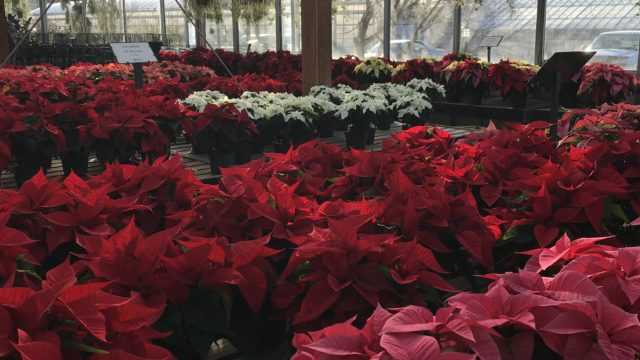
With Thanksgiving almost over, it’s officially holiday time. With holiday time comes lots of hot chocolate, ugly sweaters for your cat and dog, chronic glitter in your house, and the 5lb weight gain from uncontrollable overeating.

And as the holidays approach, out come the influx of poinsettias, holly, garlands, lilies, herbs and wreaths EVERYWHERE. After carefully curating your home all spring and summer with pet safe plants, one or more of these toxic holiday plants will inevitably end up in your home.
These are all part of dreaded Holiday Plant List, an incredibly overlooked list that includes many of these seasonal plants. While they’re only meant to be around for a few months, they are mostly toxic. Not cool, right? I, for one, did not spend all summer plant proofing my house to have a janky $5 Amaryllis give my cat diarrhea.
There is also so much misinformation out there or posts without photos. Some say Christmas trees are not toxic, some say they’ll kill the dog, some sites say Poinsettias are incredibly toxic while others say they’re safe. I can’t. With so much going on this time of year, it’s impossible to keep tabs on what comes in and out of the house and no one has time to hunt for the right information.
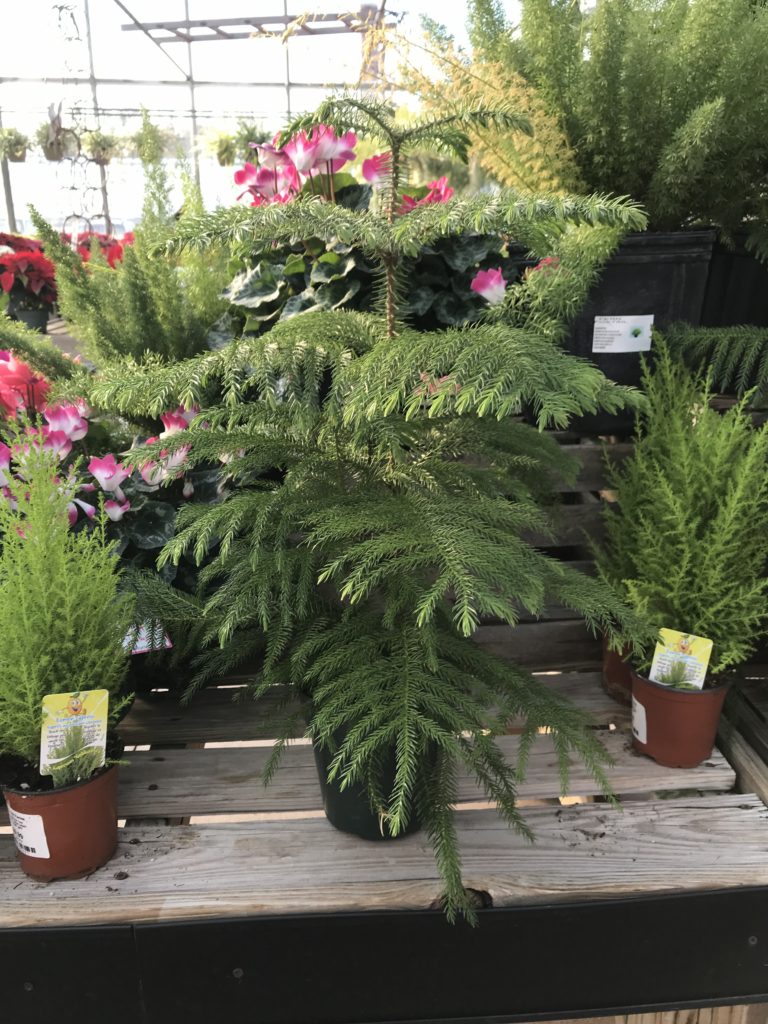
Surprise! Consider this your gift from Leaf and Paw, a complete and concise guide with all the information you need about toxic holiday plants to pets. Only sourced from real sites (like aspca and petpoisonhelpline), this is a no-nonsense post stating the facts about common holiday plants about to invade your pet-ridden household.
Toxic Holiday Plants
Ornamental Pepper
Yes, humans can technically eat these (although they don’t seem to taste good) but are toxic to cats and dogs leading to gastronomic issues.
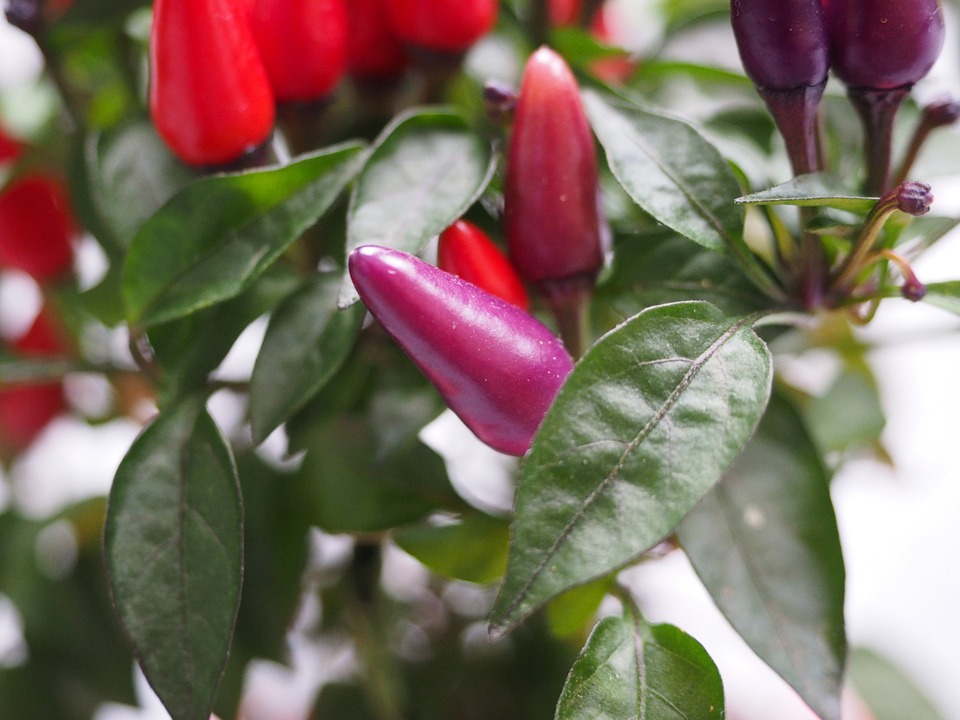
Peace Lily
Peace lilies are not exactly a holiday plant, but are a hardy houseplant typically given around holiday time. This guy is toxic as you may have guessed, due to insoluble calcium oxalates.
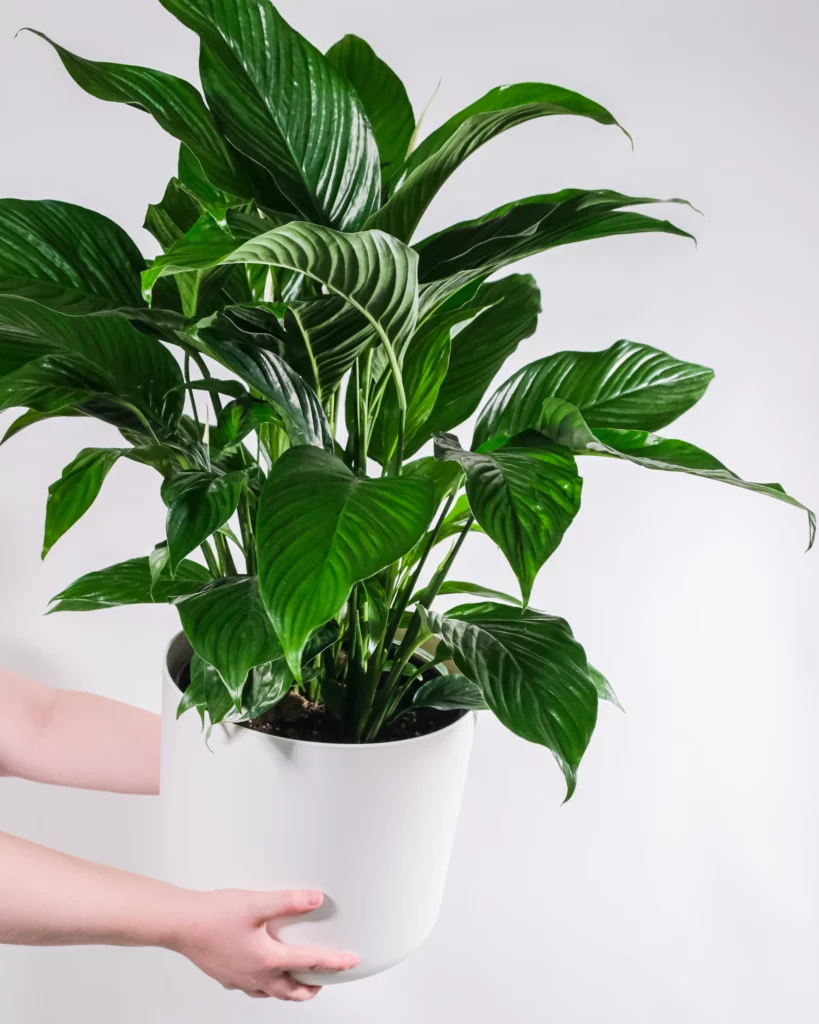
Amaryllis
Amaryllis are especially dangerous to have around holiday time. Apparently, the bulb portion looks delicious to dogs, who feel the urge to gnaw aggressively on them. All parts of Amaryllis are toxic, especially the bulb, so I would avoid these completely. Similar to Amaryllis, the unpleasantly named Pregnant Onion is toxic as well and also has a bulbous root.
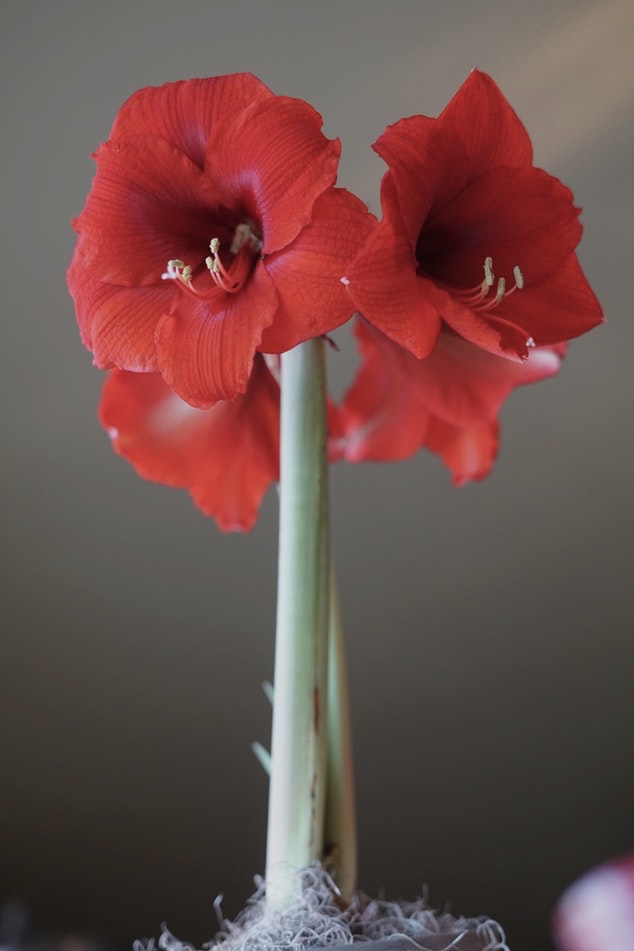
Holly
Holly should be avoided due to it being super toxic to curious kids, intoxicated friends, dogs and cats. All parts are unsafe, especially the berries. Keep any type of holly swag high on the wall.
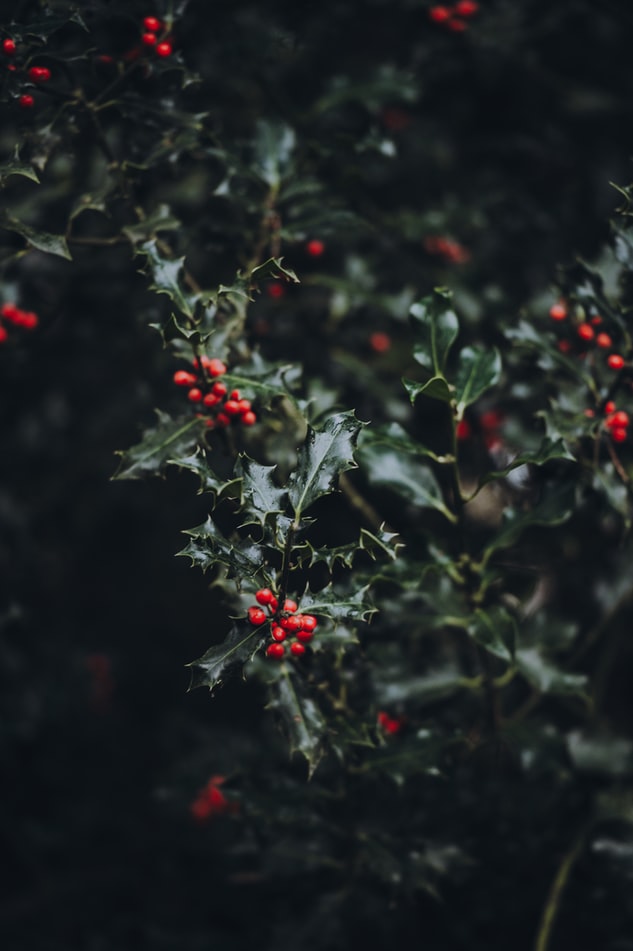
American Mistletoe
Do people actually hang mistletoe anymore? For those who do who are not in a Hallmark film, keep mistletoe high up as well, out of reach of cats and dogs. Often overlooked, here are one of the most toxic holiday plants.
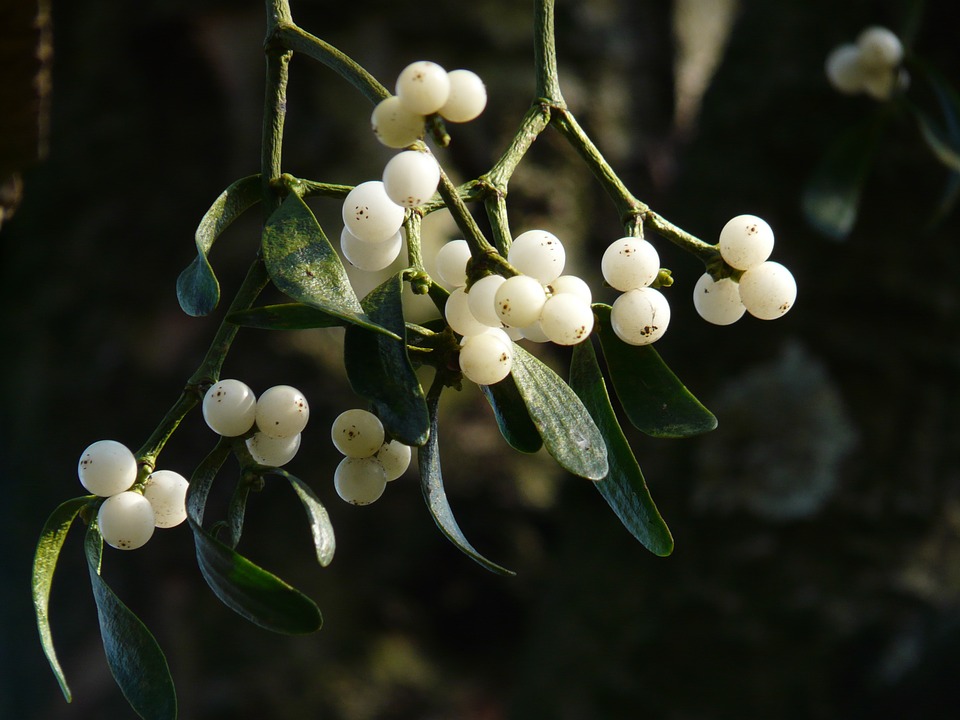
Cyclamen
All parts of Cyclamen are pretty toxic, so I never let these come in my house despite how lovely they seem.
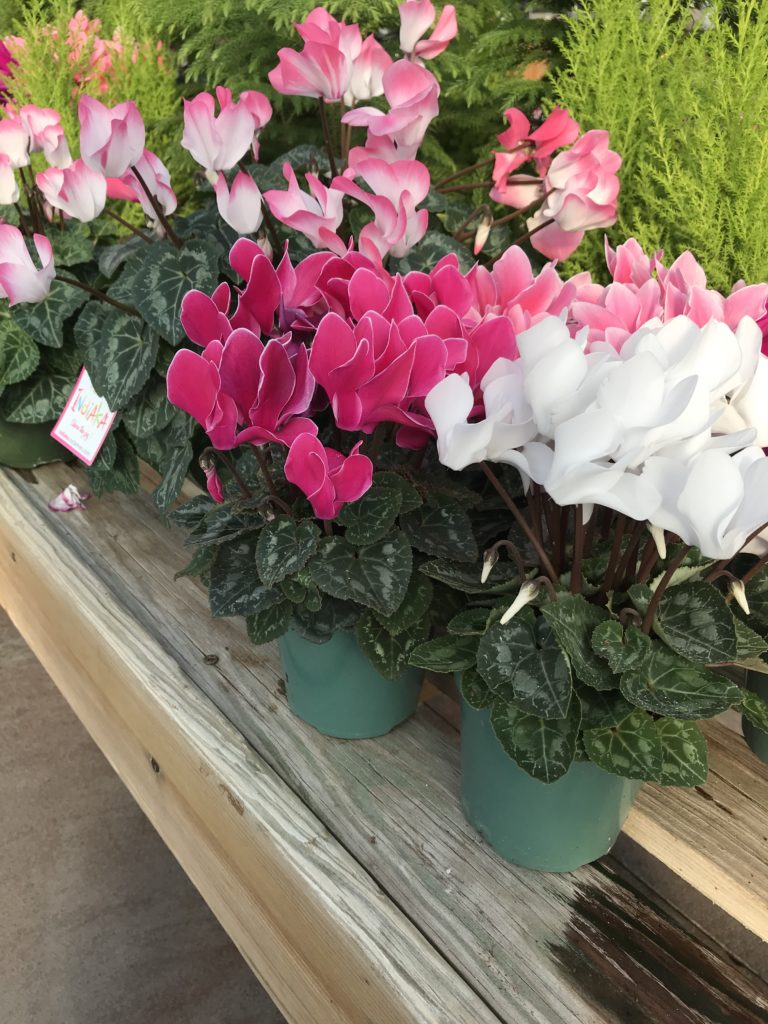
Lilies
These are different lilies than the Peace Lily I mention above, but are way more toxic and part of the Lilium genus. Typically seen in floral arrangements, these are the smelly ones where all parts of the flower are very deadly to cats. I won’t even let them in my house. They’re sometimes given as gifts in the winter in which case I hand them right back.

What About Poinsettias?
Poinsettias are the most misunderstood holiday plant, I think. Because only some parts of the plant are considered toxic, it generally gets overrated in toxicity.
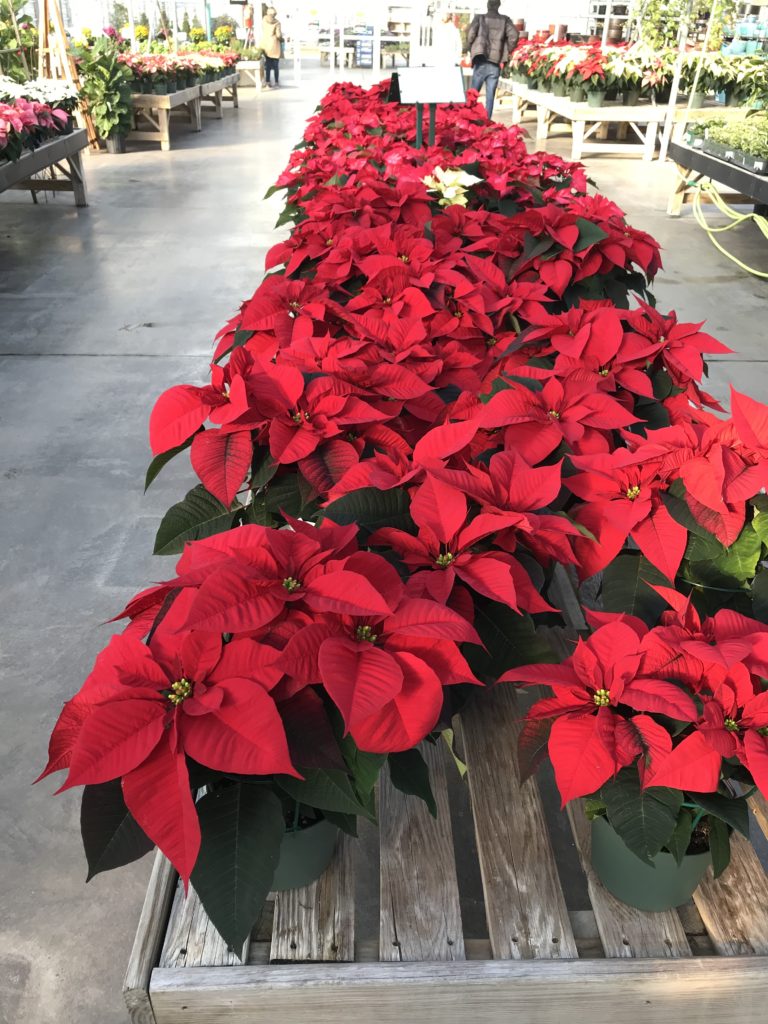
Here’s the deal: Poinsettias are considered non toxic plants. The white sap that excretes when a leaf brakes off is the only part to be mildly toxic to both cats and dogs. It can be irritating to the mouth and stomach, and can cause vomiting. I don’t keep Poinsettias in my home because of a different and often overlooked issue – pesticides. Poinsettias are usually heavily sprayed with pesticides (not all of them, you can ask the garden center), which I’m not a fan of.
The verdict? At the end of the day, these are non toxic but if you have curious cats or dogs I would opt for a safe plant below.
Safe Holiday Plants
Squash
What’s a better decoration than actual food you could eat later? Acorn squash, Butternut squash, Buttercup squash, and Pumpkins are all safe for cats and dogs to be around.
Christmas Cactus
These are my favorite holiday plant because they are 100% non toxic and really pretty. They even come in a bunch of different colors like white, blush, pink and red. Caring for these is simple too. Treat Christmas cacti like a Hoya; water when the soil is dry and keep in medium to bright sun.
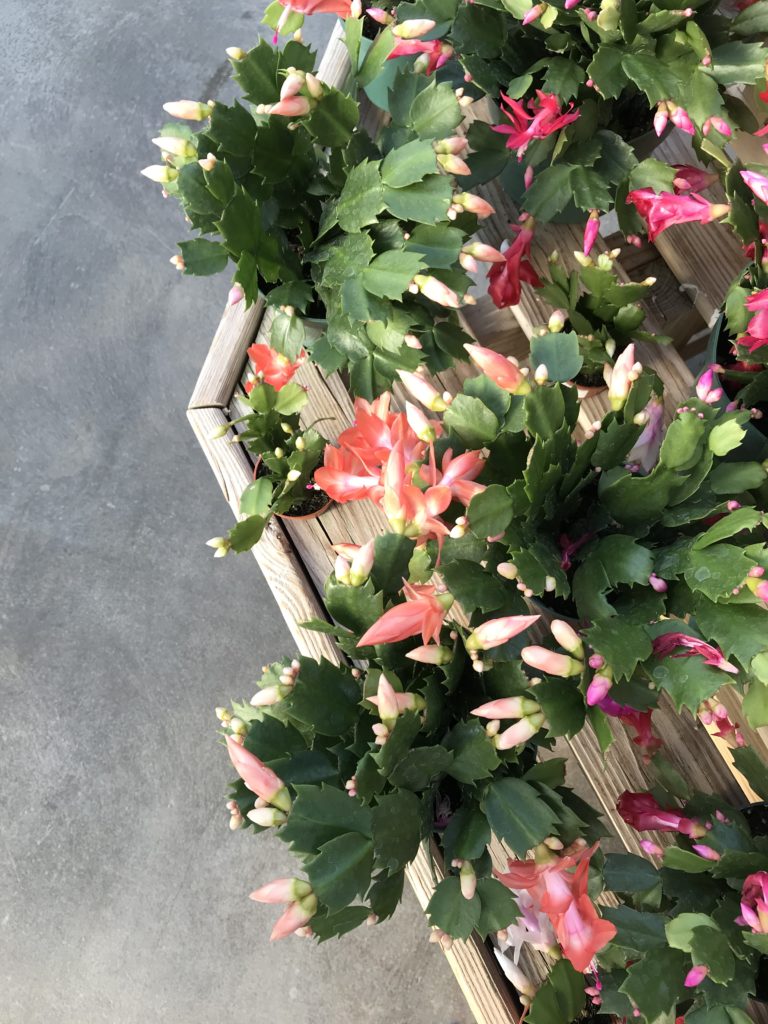
Phalaenopsis Orchids
Orchids are now being considered a holiday plant, which is weird, but I’m ok with it. Completely non-toxic, Phalaenopsis orchids look very pretty as centerpieces on tables and in bathrooms when company visits. Keep orchids in a bright location and water with three ice cubes or soak roots once a week.
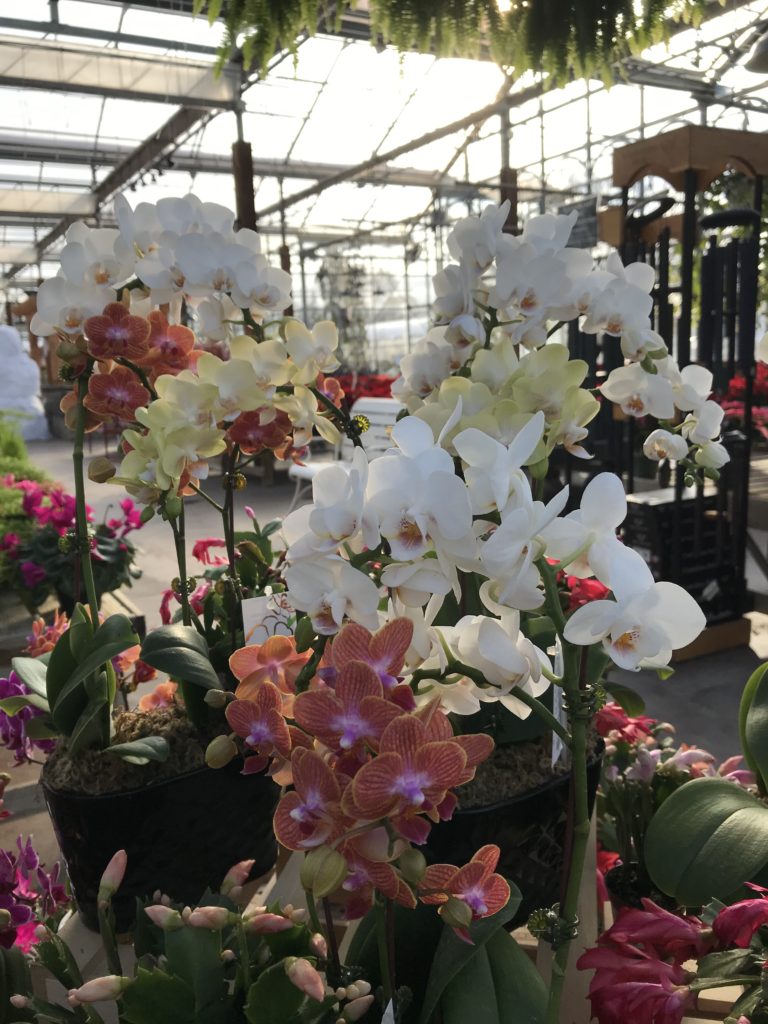
Frosty Ferns
These adorable little ferns are perfect holiday plants. They even look like they have snow on them. More substantial than a maidenhair fern (the bane of my existence), Frosty ferns like medium to low light, humidity and to be kept moist.
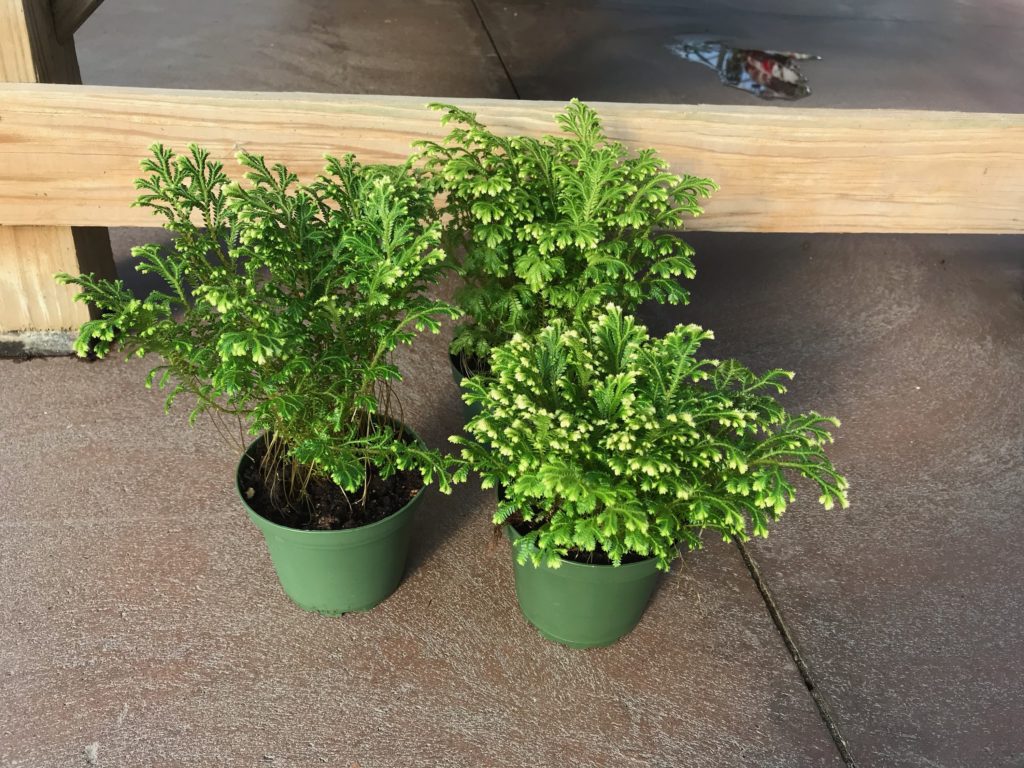
The Scoop on Christmas Trees
I grew up with a live Christmas tree in my house around the holidays – not a real one that was cut down to die in a few weeks, but a tree with a root ball sitting in water in our living room as a Christmas tree. When Christmas decorations came down, the tree was planted outside. I really love this idea but I didn’t have cats or dogs back then. Since I’m not a fan of cut Christmas trees, I chose a slim fake one as an adult, but still love the idea of live trees. Common types for sale: Australian, Norfolk, and Norfolk Island Pine (think of the Charlie Brown tree).
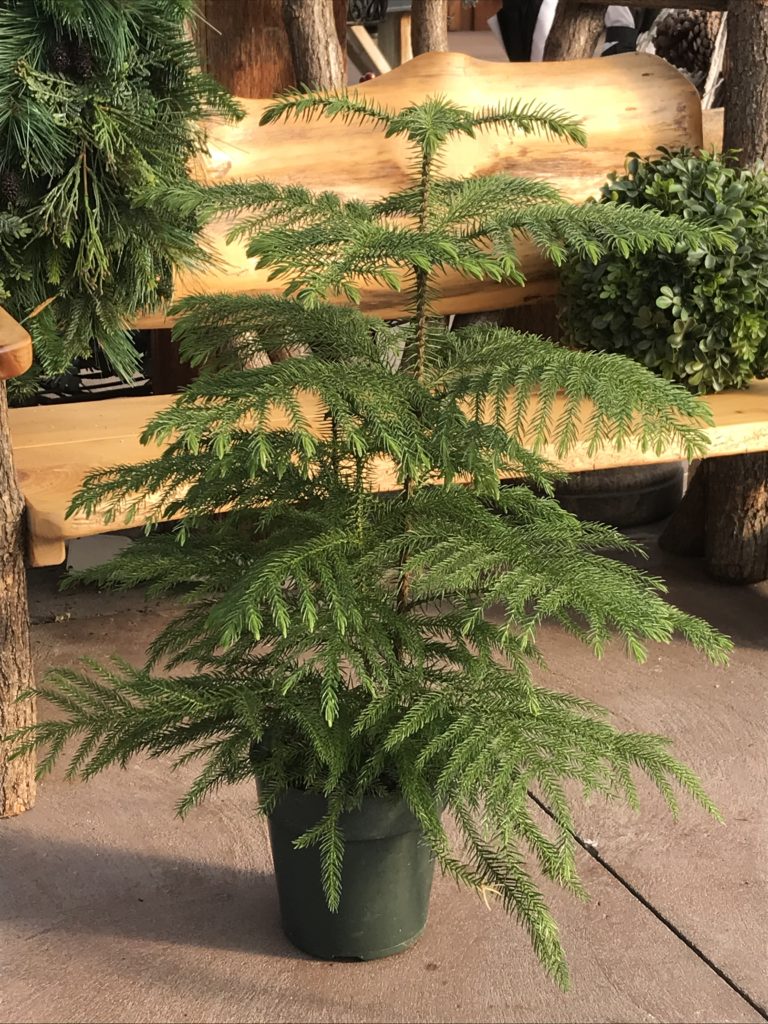
Here are a few things to think about if you have pets and live trees at home:
- Christmas tress with or without root balls sit in water. That water can hold bacteria, molds, and fertilizers. Remember that cats and dogs tend to drink out of standing water sources in the home (aka toilets). This toxic water can be a concern and can cause sickness if swallowed even in small amounts.
- Sap and oils from trees can be irritating to pet faces, eyes and cause frustration to humans who hate sticky things.
- Pine tree needles can poke pet’s eye or cause obstructions if swallowed.
Other Holiday Dangers
Besides plants, let’s not forget to be aware of some overlooked holiday decor that can not be so merry in the paws of cats and dogs:
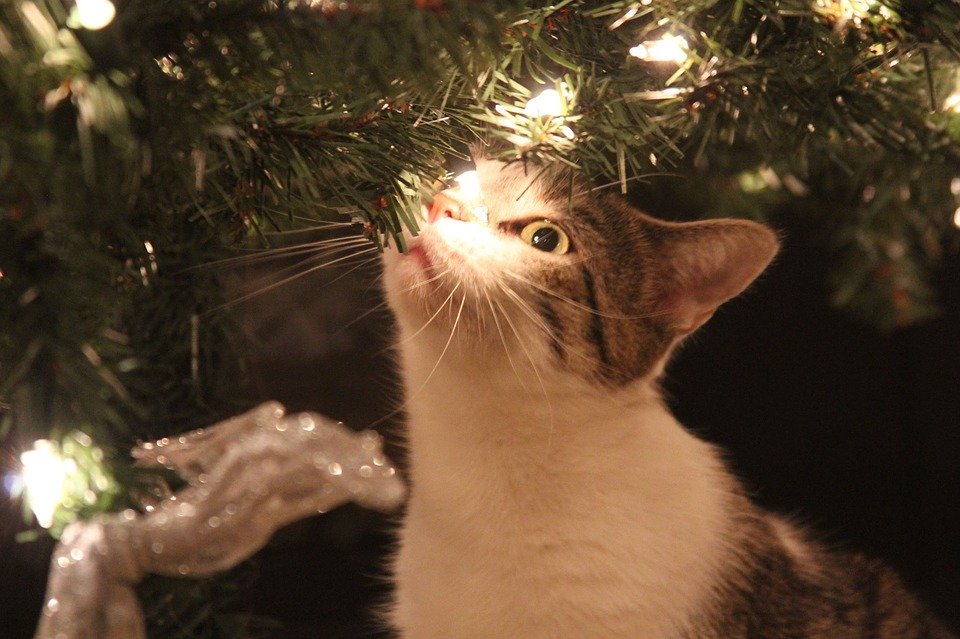
Candles
Pets sniff everything and not all pets are smart. Candles can burn noses and tails plus poor quality candles’ scents can be overwhelming for pets. Place candles in out of reach places and burn only high quality soy candles – I like these.
Chocolate
No news here, chocolate is bad for dogs, so keep it off floors and coffee tables. Waistlines will thank you too.
Tinsel
Oh God, the tinsel. Why is idiotic tinsel even made anymore – it’s an abomination to the environment. Cats eat anything stringy and silvery. It’s super dangerous and can get stuck in lungs and/or butt. Usually it’s the latter and it’s gross.
Glass Ornaments
You can’t even tell the different between glass and plastic anyway. Do yourself a favor and eliminate shattering ornaments from the tree your cats will inevitably climb.

I hope this list helps relive the stress of holiday plants (or maybe it made it worse). For an abridged version of this post, check out my pinnable infographic below. Happy holidays!
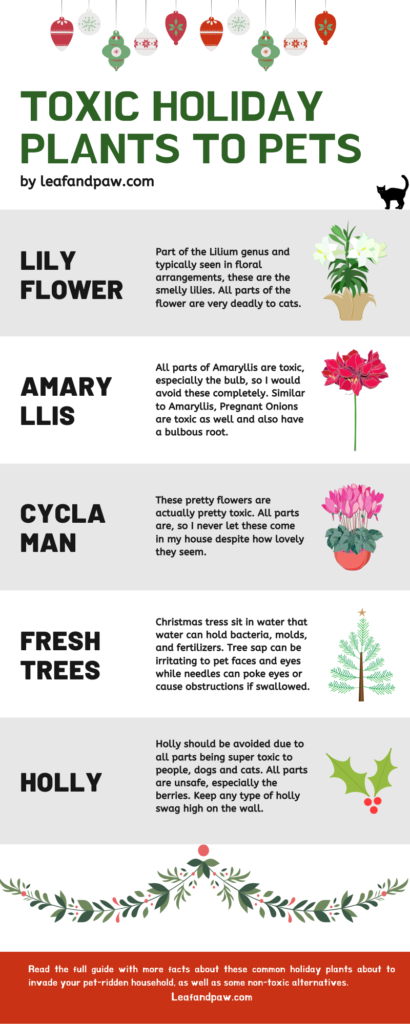


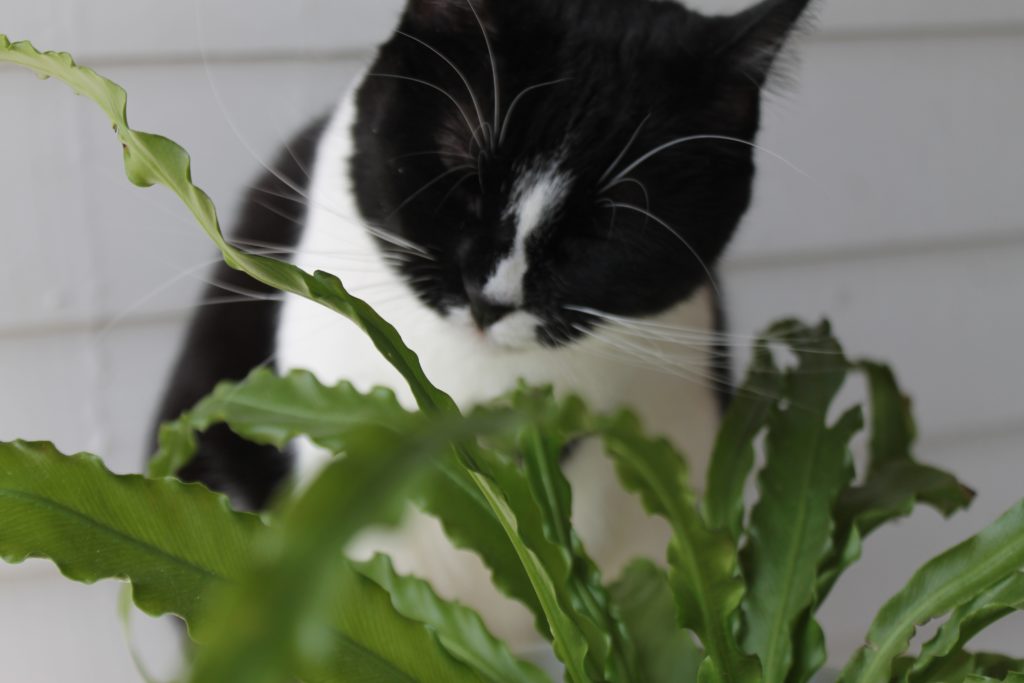
Poinsettias are pretty safe. I’ve taken to the habit of bringing one to the toxicology class every year and eating a leaf in front of the veterinary studies. Poinsettias are not delicious, but I haven’t died yet.
Omg hi Karyn! And that’s good to know. 🙂 -Anastasia
Great article and very comprehensive! Very happy to have discovered your site!
Great article! I found you on Instagram. I look forward to getting to know you and your kitties!
Gentle note: Ice cubes are dangerous for the roots of orchids. I lost many beautiful plants before I learned this. I water my orchids, let them drain completely before returning them to their outer pots, and then water again when the roots turn silver and the medium appears a bit dry.
Hi Dana, The ice cube method has worked for me for years, I get blooms every 4 months or so, but my orchids have a a very chunky mix of bark and moss mixed in with their roots, which makes the ice cubes work best. But I agree, ice cubes can damage roots if they are more exposed. Thanks for sharing!